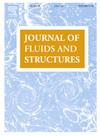Correlating the Den Hartog instability criterion to the dynamic response of an oscillating system in elevated free-stream turbulence
IF 3.5
2区 工程技术
Q1 ENGINEERING, MECHANICAL
引用次数: 0
Abstract
The Den Hartog criterion has been used to evaluate the susceptibility of a cross-section to galloping instability. We present results from novel experiments aimed at correlating the Den Hartog stability assessment of an altered circular cross-section and the dynamic response of a 1D self-excited oscillator in an inflow with elevated free-stream turbulence levels, with turbulence intensities of 13.4 % and 19.4 %. The results were compared with a quasi-laminar inflow case with a background turbulence intensity of < 2 %. Dynamic tests were performed on a circular cylinder with attached strips of various thicknesses, from 0 – 8.2 % of the cylinder diameter. The Reynolds number range for the reported experiments was 1800 – 31900 across both inflow conditions. Both sets of results are compared with static tests involving thicknesses varying from 0 to 12.8 % at Reynolds numbers from 10000 to 30000. The maximum angles of attack of the vibrating configurations were projected onto the Den Hartog instability map generated from fixed cylinder lift‒drag measurements, and the maximum angle experienced by the cylinder that underwent galloping fell within the Den Hartog instability zones. Increasing the strip thickness postpones the angle at which the lift reaches its maximum and increases the maximum lift and drag values. The effects of elevated turbulence on the Den Hartog criteria are evaluated, and the results suggest that inflow turbulence eliminates the galloping instability branch close to 90°. Free-stream turbulence also reduces the vortex shedding frequency and eliminates the abrupt changes in lift observed in the laminar inflow cases.

Den Hartog不稳定判据与自由湍流中振荡系统动态响应的关联
Den Hartog准则已被用于评价截面对驰动不稳定性的敏感性。我们提出了新的实验结果,旨在将改变圆形截面的Den Hartog稳定性评估与一维自激振荡器在湍流强度为13.4%和19.4%的自由流湍流水平升高的流入中的动态响应联系起来。结果与背景湍流强度为<的准层流流入情况进行了比较;2%。在圆柱体上进行了动态试验,并附有不同厚度的条,从圆柱体直径的0 - 8.2%。在两种流入条件下,所报告的实验的雷诺数范围为1800 - 31900。两组结果都与静态测试进行了比较,测试涉及的厚度从0到12.8%不等,雷诺数从10000到30000。将振动构型的最大迎角投影到由固定气缸升阻测量生成的Den Hartog不稳定图上,发现气缸经历的最大迎角落在Den Hartog不稳定区域内。增加带钢厚度会推迟升力达到最大的角度,并增加最大升力和阻力值。研究了湍流升高对Den Hartog准则的影响,结果表明流入湍流消除了90°附近的驰动不稳定分支。自由流湍流也降低了旋涡脱落的频率,消除了层流流入情况下升力的突变。
本文章由计算机程序翻译,如有差异,请以英文原文为准。
求助全文
约1分钟内获得全文
求助全文
来源期刊

Journal of Fluids and Structures
工程技术-工程:机械
CiteScore
6.90
自引率
8.30%
发文量
173
审稿时长
65 days
期刊介绍:
The Journal of Fluids and Structures serves as a focal point and a forum for the exchange of ideas, for the many kinds of specialists and practitioners concerned with fluid–structure interactions and the dynamics of systems related thereto, in any field. One of its aims is to foster the cross–fertilization of ideas, methods and techniques in the various disciplines involved.
The journal publishes papers that present original and significant contributions on all aspects of the mechanical interactions between fluids and solids, regardless of scale.
 求助内容:
求助内容: 应助结果提醒方式:
应助结果提醒方式:


